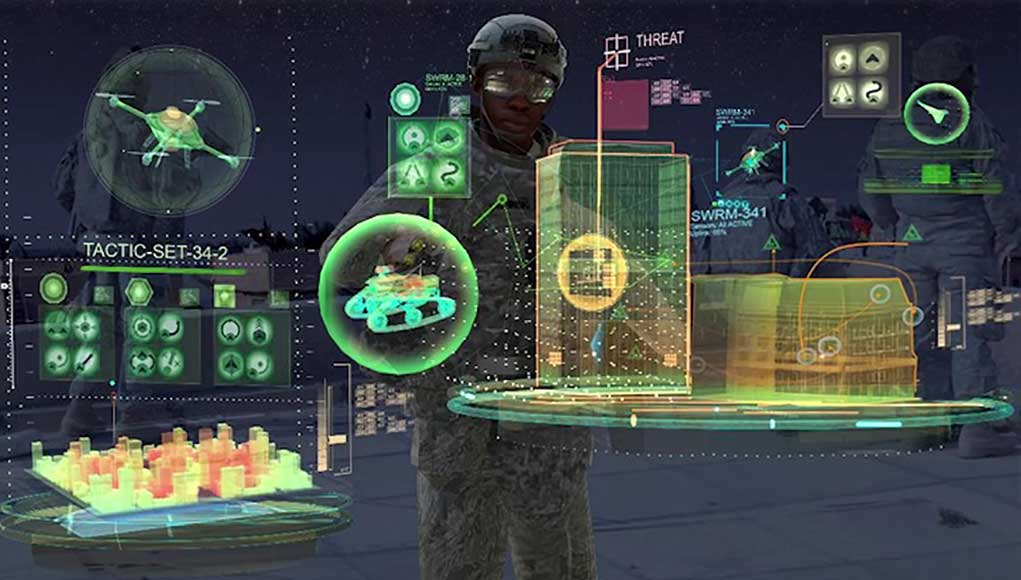
Unmanned systems are widely used by the military in numerous missions, assisting soldiers and operators in tedious and dangerous tasks. But in the near future, robotic systems will assume collaborative missions without human control, helping other robots performing complete missions autonomously.
The tools and methods required to conduct such missions are currently being evaluated by the US Defense Advanced Research Projects Agency (DARPA), under the ‘OFFensive Swarm-Enabled Tactics’ (OFFSET) program. The aim of this project is to develop the tools to operate and control swarms of 250 collaborative autonomous systems. Such a swarm will be able to provide soldiers fighting in an urban area the critical insights of the terrain. These flying bots will enter high rises, subterranean and indoor spaces to improve situational awareness, communications, and mobility. Currently, at its third phase, DARPA’s OFFSET Sprint focuses on the aspects of human-swarm teaming and tactics.
Timothy Chung, program manager in DARPA’s Tactical Technology Office (TTO) encouraged researchers and innovators from existing participants and new ones to join third OFFSET sprint. “What makes autonomous swarm research challenging and compelling is the rapid pace at which swarm technologies and associated capabilities are advancing,” Chung said. “OFFSET is designed around the idea of incorporating core swarm sprints at regular intervals.” OFFSET is structured to demonstrate its technologies through frequent live experiments with various unmanned air and ground platforms. Roughly every six months,
The first of two topic areas covered in the third sprint is human-swarm teaming, which refers to the design, development, and demonstration of novel frameworks to enhance how humans interact with autonomous swarms. This topic area recognizes and seeks to address the complexity of the swarm systems themselves, as well as the cognitive, physical, and contextual needs of human teammates or tacticians when conducting urban operations.

The third swarm sprint seeks to increase the collection of swarm tactics available for the user. At this third sprint, participants will be required to employ heterogeneous swarms of aerial and ground robots, performing autonomous and collaborative maneuvers on a specific mission. For example, they will be tasked to conduct an urban raid, within four square city blocks, over a mission duration of one-to-two hours.
Among the concepts being evaluated are immersive and intuitive interactive technologies, augmented and virtual reality, with voice-, gesture-, and touch-based) interactions. This will create a novel command interface with immersive situational awareness and decision presentation capabilities. The interface would also incorporate a swarm interaction grammar, enabling “freestyle” design of swarm tactics that allow dynamic action and reaction based on real-time conditions in the field. These tactics will be executed in a virtual simulation representing a swarm tactics game. Different tactics will be evaluated to explore and evolve the most effective and promising ones. Users could submit swarm tactics and track their performance from test rounds, or join with other concepts loaded to the program’s swarm tactics exchange, to design swarm tactics by composing collective behaviors, swarm algorithms, and tactics.
The program envisions five Sprints, each focuses on one or more topics including swarm tactics, swarm autonomy, human-swarm teaming, virtual environment, and physical testbed. Each topic emphasizes slightly different perspectives but ultimately aims to enable breakthroughs in swarm capabilities.
The second Sprint embraced some of the innovative technologies and new ideas evaluated in the first OFFSET Sprint. As part of the second Sprint DARPA has recently awarded contracts to the following organizations:
The first sprint included teams lead by technology giants Raytheon, Northrop Grumman, and Lockheed Martin. Each company teamed with an academic research center. The second sprint focused primarily on research institutes, including Carnegie Mellon and Cornell universities, Michigan Technological University, and the Universities of Boulder, Colorado, and Charlotte, North Carolina. Corenova Technologies, Heron Systems, and Siemens Corporation were also awarded research contracts as part of the Second OFFSET Sprint.
“This cohort of sprinters for the second swarm will leverage existing technologies or develop new ones leading to enhancements in swarm autonomy, highlighting enriched foundations in swarm primitives and/or swarm algorithms,” Chung said, “These contributions to the overarching OFFSET swarm systems architectures will offer additional building blocks for novel capabilities that spotlight the potentially disruptive advantages of autonomous swarms for complex urban operations.”



















